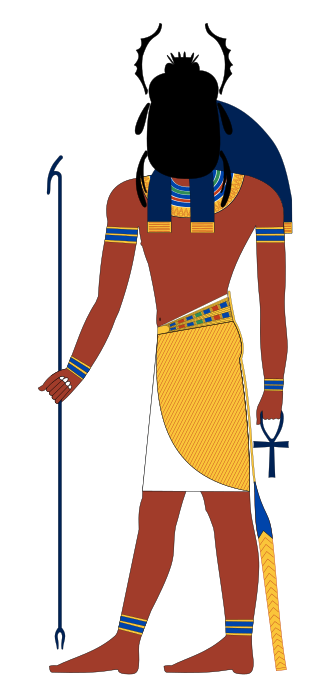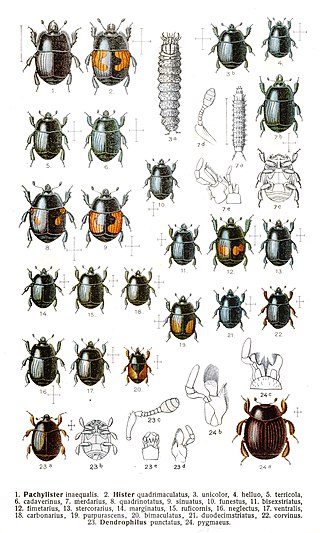
Beetles are insects that form the order Coleoptera, in the superorder Endopterygota. Their front pair of wings are hardened into wing-cases, elytra, distinguishing them from most other insects. The Coleoptera, with about 400,000 described species, is the largest of all orders, constituting almost 40% of described insects and 25% of all known animal species; new species are discovered frequently, with estimates suggesting that there are between 0.9 and 2.1 million total species. Found in almost every habitat except the sea and the polar regions, they interact with their ecosystems in several ways: beetles often feed on plants and fungi, break down animal and plant debris, and eat other invertebrates. Some species are serious agricultural pests, such as the Colorado potato beetle, while others such as Coccinellidae eat aphids, scale insects, thrips, and other plant-sucking insects that damage crops.

A galaxy is a system of stars, stellar remnants, interstellar gas, dust, and dark matter bound together by gravity. The word is derived from the Greek galaxias (γαλαξίας), literally 'milky', a reference to the Milky Way galaxy that contains the Solar System. Galaxies, averaging an estimated 100 million stars, range in size from dwarfs with less than a hundred million stars, to the largest galaxies known – supergiants with one hundred trillion stars, each orbiting its galaxy's center of mass. Most of the mass in a typical galaxy is in the form of dark matter, with only a few percent of that mass visible in the form of stars and nebulae. Supermassive black holes are a common feature at the centres of galaxies.

Light pollution is the presence of unwanted, inappropriate, or excessive artificial lighting. In a descriptive sense, the term light pollution refers to the effects of any poorly implemented lighting, during the day or night. Light pollution can be understood not only as a phenomenon resulting from a specific source or kind of pollution, but also as a contributor to the wider, collective impact of various sources of pollution.

Khepri is a scarab-faced god in ancient Egyptian religion who represents the rising or morning sun. By extension, he can also represent creation and the renewal of life.

Bioluminescence is the production and emission of light by living organisms. It is a form of chemiluminescence. Bioluminescence occurs widely in marine vertebrates and invertebrates, as well as in some fungi, microorganisms including some bioluminescent bacteria, and terrestrial arthropods such as fireflies. In some animals, the light is bacteriogenic, produced by symbiotic bacteria such as those from the genus Vibrio; in others, it is autogenic, produced by the animals themselves.

Dung beetles are beetles that feed on feces. Some species of dung beetles can bury dung 250 times their own mass in one night.

Histeridae is a family of beetles commonly known as clown beetles or hister beetles. This very diverse group of beetles contains 3,900 species found worldwide. They can be easily identified by their shortened elytra that leaves two of the seven tergites exposed, and their geniculate (elbowed) antennae with clubbed ends. These predatory feeders are most active at night and will fake death if they feel threatened. This family of beetles will occupy almost any kind of niche throughout the world. Hister beetles have proved useful during forensic investigations to help in time of death estimation. Also, certain species are used in the control of livestock pests that infest dung and to control houseflies. Because they are predacious and will even eat other hister beetles, they must be isolated when collected.

There are many myths and legends about the origin of the Milky Way, the crowd of stars that makes a distinctive bright streak across the night sky.

The Milky Way is the galaxy that includes the Solar System, with the name describing the galaxy's appearance from Earth: a hazy band of light seen in the night sky formed from stars that cannot be individually distinguished by the naked eye. The term Milky Way is a translation of the Latin via lactea, from the Greek γαλακτικὸς κύκλος, meaning "milky circle". From Earth, the Milky Way appears as a band because its disk-shaped structure is viewed from within. Galileo Galilei first resolved the band of light into individual stars with his telescope in 1610. Until the early 1920s, most astronomers thought that the Milky Way contained all the stars in the Universe. Following the 1920 Great Debate between the astronomers Harlow Shapley and Heber Doust Curtis, observations by Edwin Hubble showed that the Milky Way is just one of many galaxies.
The most recent understanding of the evolution of insects is based on studies of the following branches of science: molecular biology, insect morphology, paleontology, insect taxonomy, evolution, embryology, bioinformatics and scientific computing. It is estimated that the class of insects originated on Earth about 480 million years ago, in the Ordovician, at about the same time terrestrial plants appeared. Insects are thought to have evolved from a group of crustaceans. The first insects were landbound, but about 400 million years ago in the Devonian period one lineage of insects evolved flight, the first animals to do so. The oldest insect fossil has been proposed to be Rhyniognatha hirsti, estimated to be 400 million years old, but the insect identity of the fossil has been contested. Global climate conditions changed several times during the history of Earth, and along with it the diversity of insects. The Pterygotes underwent a major radiation in the Carboniferous while the Endopterygota underwent another major radiation in the Permian.

The Andromeda–Milky Way collision is a galactic collision predicted to occur in about 4.5 billion years between the two largest galaxies in the Local Group—the Milky Way and the Andromeda Galaxy. The stars involved are sufficiently far apart that it is improbable that any of them will individually collide. Some stars will be ejected from the resulting galaxy, often nicknamed Milkomeda or Milkdromeda, a portmanteau of the respective galaxy names.

Scarabaeus sacer, common name sacred scarab, is the type species of dung beetles in its genus and the family Scarabaeidae.

Dung middens, also known as dung hills, are piles of dung that mammals periodically return to and build up. They are used as a form of territorial marker. A range of animals are known to use them including steenbok, hyrax, and rhinoceros. Other animals are attracted to middens for a variety of purposes, including finding food and locating mates. Some species, such as the dung beetle genus Dicranocara of the Richtersveld in South western Africa spend their whole lifecycle in close association with dung middens. Dung middens are also used in the field of Paleobotany, which relies on the fact that each ecosystem is characterized by certain plants, which in turn act as a proxy for climate. Dung middens are useful as they often contain pollen which means fossilized dung middens can be used in Paleobotany to learn about past climates.
The Australian Dung Beetle Project (1965–1985), conceived and led by Dr George Bornemissza of the Commonwealth Scientific and Industrial Research Organisation (CSIRO), was an international scientific research and biological control project with the primary goal to control the polluting effects of cattle dung.

George Francis Bornemissza was a Hungarian-born entomologist and ecologist. He studied science at the University of Budapest before obtaining his Ph.D. in zoology at the University of Innsbruck in Austria in 1950. At the end of that year, he emigrated to Australia. There he first worked in the Department of Zoology at the University of Western Australia for 3 years, before pursuing a career with the Commonwealth Scientific and Industrial Research Organisation (CSIRO). Bornemissza was known for his work on the Australian Dung Beetle Project (1965–1985) while working at CSIRO's Division of Entomology. He wrote scientific papers and books based on his research and contributed a collection of mounted beetle specimens to the Australian National Insect Collection and the Tasmanian Museum and Art Gallery. In 2001 he was awarded the Medal of the Order of Australia for his services to Australian entomology.

Animal navigation is the ability of many animals to find their way accurately without maps or instruments. Birds such as the Arctic tern, insects such as the monarch butterfly and fish such as the salmon regularly migrate thousands of miles to and from their breeding grounds, and many other species navigate effectively over shorter distances.
Professor Marcus Byrne won the 2013 Ig Nobel Prize for Biology/Astronomy along with: Marie Dacke, Emily Baird, Clarke Scholtz, and Eric Warrant, for discovering that when dung beetles get lost, they can navigate their way home by looking at the Milky Way. This research has practical applications, for example helping how to develop complex visual systems.
Many animals are able to navigate using the Sun as a compass. Orientation cues from the position of the Sun in the sky are combined with an indication of time from the animal's internal clock.

Deltochilini is a tribe of scarab beetles, in the dung beetle subfamily (Scarabaeinae). Members of this group vary widely in size and shape, but were thought to be derived from an ancient ball-rolling lineage. The outer edges of the front tibiae have less than four teeth. The grouping based on these characteristics has, however, been found to have little phylogenetic validity, and the placement of several genera in the tribe is likely to change.
Marie Ann-Charlotte Dacke is a professor in the Lund Vision Group at Lund University in Sweden. She received an Ig Nobel Prize in 2013 for her work on the navigation system of dung beetles. She is also a panel member on the Swedish TV show Studio Natur, and was named best science communicator in Sweden during the 2012 Forskar Grand Prix.















